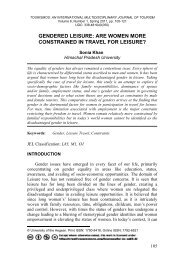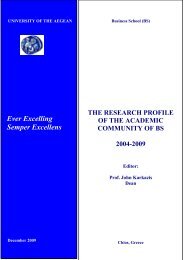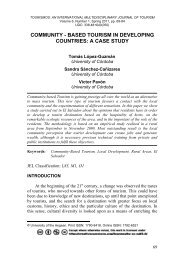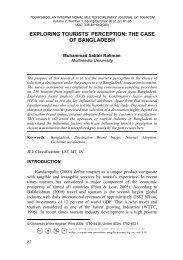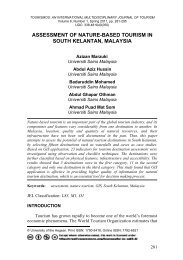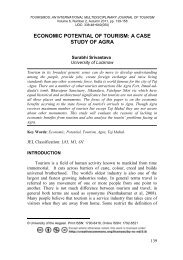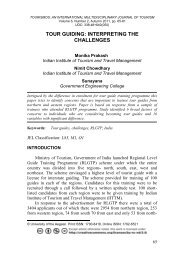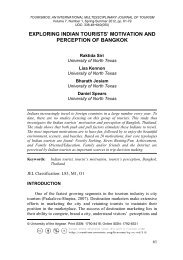TOURISMOS is an international, multi-disciplinary, refereed (peer ...
TOURISMOS is an international, multi-disciplinary, refereed (peer ...
TOURISMOS is an international, multi-disciplinary, refereed (peer ...
Create successful ePaper yourself
Turn your PDF publications into a flip-book with our unique Google optimized e-Paper software.
Ju<strong>an</strong> Gabriel Brida, Linda Osti & Esther S<strong>an</strong>tifaller<br />
fulfil a very import<strong>an</strong>t word-to-mouth function, especially if they belong<br />
to key customer groups.<br />
On the other h<strong>an</strong>d, th<strong>is</strong> phenomenon causes a series of problems <strong>an</strong>d<br />
difficulties mainly connected to a lack of sustainable development of a<br />
destination. A large territory <strong>is</strong> needed for just a few overnight stays of<br />
the owner. Often second homes are not rented out <strong>an</strong>d are only used by<br />
the owners.<br />
The size of the second home market <strong>is</strong> subst<strong>an</strong>tial. For example, in<br />
Finl<strong>an</strong>d it <strong>is</strong> estimated that in 2003 there were 465.000 second homes<br />
me<strong>an</strong>ing that every sixth family owned a second home, while every<br />
second family had access to a second home through friends or extended<br />
family relations (Hall <strong>an</strong>d Page, 2006). While some countries actively<br />
seek tr<strong>an</strong>snational investment by second home purchasers, for example<br />
Malaysia <strong>an</strong>d Dubai, other countries, notably Australia, impose barriers to<br />
second home ownership by non-citizens.<br />
The question as to whether second homes are a curse or blessing to<br />
the receiving communities <strong>is</strong> still rather difficult to <strong>an</strong>swer. It depends on<br />
both structural <strong>an</strong>d perceptual <strong>is</strong>sues. To maximize the positive effects<br />
<strong>an</strong>d to minimize the negative effects local authorities should include<br />
second home development in their country development pl<strong>an</strong>s. A better<br />
underst<strong>an</strong>ding of the second home development <strong>is</strong> essential <strong>an</strong>d questions<br />
need to be asked about the role of second home owners, l<strong>an</strong>d use policies,<br />
property taxation <strong>an</strong>d service prov<strong>is</strong>ion. Furthermore, second home<br />
pl<strong>an</strong>ning <strong>is</strong>sues need to be continuously adjusted, because ch<strong>an</strong>ges in<br />
population d<strong>is</strong>tribution, population composition, family structures <strong>an</strong>d<br />
tour<strong>is</strong>m preferences all affect the future second home tour<strong>is</strong>m.<br />
While m<strong>an</strong>y people own second homes as rental properties <strong>an</strong>d<br />
fin<strong>an</strong>cial investments, here we focus on second homes that function as<br />
recreational or vacation properties. The aim of th<strong>is</strong> research <strong>is</strong> to <strong>an</strong>alyse<br />
<strong>an</strong>d determine local residents’ attitudes towards the second home<br />
phenomenon, to underst<strong>an</strong>d the ch<strong>an</strong>ges that the growth of second home<br />
bring to their life by <strong>an</strong>alysing concerns <strong>an</strong>d the <strong>is</strong>sues that they face as a<br />
result of second home development. Furthermore, th<strong>is</strong> research provides<br />
<strong>an</strong> insight into second home owners, who they are, why they bought a<br />
second home <strong>an</strong>d the use they make of their second home. The final<br />
objective of th<strong>is</strong> research <strong>is</strong> to provide a hol<strong>is</strong>tic picture of the h<strong>is</strong>torical<br />
context of second homes <strong>an</strong>d to underst<strong>an</strong>d future developments. The<br />
field of research <strong>is</strong> South-Tyrol, <strong>an</strong> autonomous province in northern Italy<br />
of 7,400 km 2 (of which 64% over 1,500 meters above sea level) counting<br />
10,526 second homes.<br />
142



